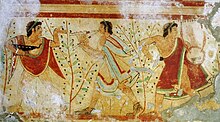Tomba dei Leopardi
The Tomba dei Leopardi (German "grave of the leopards ") is a decorated Etruscan grave in the Monterozzi necropolis near Tarquinia .
The grave was found and excavated in 1875. It consists of a small chamber (approx. 4 m × 4 m in size) that is completely painted. In the gable of the back wall, two leopards are depicted, which gave the grave its name. Because of the good preservation of the colors, this tomb is considered to be one of the prime examples of Etruscan art.
The grave from the 1st half of the 5th century BC. BC shows that the program of tomb painting has now increasingly turned to banquet scenes. The “couple on the kline ” (dining bed) becomes the most important single scene of this phase . The leopard grave represents the first stage in this development. Three couples are gathered on the Kline. The scene on the back wall of the grave is shown on the left, i.e. on the most important side that you see first when you enter the grave. Two of the couples consist of man and woman, one couple - on the far left - of two men.
Only one pair, namely the one in the middle, probably the most important one, is served by two naked young men. In the gable of the back wall, two sleek leopards face each other axially symmetrically, which gave the grave its name. Since the interest in tomb painting is now shifting from the architectural structures to uniform scenes and giving way to a more pronounced sense of the decorative, the leopards are no longer separated by the false consoles that were supposed to support the roof, but by an elegant one Tree. A strongly realistic sense characterizes this work - it is noticeable in the variety of clothing, in the different portrayals of the people in profile, which vary greatly from one another and thus reveal the desired portrait similarity.
With the end of the late archaic era around 460 BC The height of Etruscan tomb painting was exceeded. From the following period to about 300 BC A far smaller number of painted graves is known to exist. The subject of the picture focuses on motifs that have now become canonical, such as feasts, musicians and dance scenes and athletic games. The formal development seems to have stopped from a certain level - also in contrast to Greece.
Great importance was attached to the reproduction of nature: in the center there is a stylized palm tree, reeds and bluebells are distributed over the entire image field and pomegranate blossoms form the upper frame.
literature
- Horst Blanck : Finds from the Tomba dei Leopardi (Tarquinia). In: Yearbook of the German Archaeological Institute . Volume 103, 1988, pp. 201-216.
- Mario Moretti , Leonard von Matt : Etruscan painting in Tarquinia . DuMont Schauberg, Cologne 1974, ISBN 3-7701-0541-9 , p. 92 fig. 74-77.
- Stephan Steingräber : Etruria. Cities, sanctuaries, necropolises . Hirmer, Munich 1981, ISBN 3-7774-3330-6 , p. 390.
Web links
- The Tomb of the Leopards at Tarquinia
- Tomba dei Leopardi on necropoliditarquinia.it (Italian)
Remarks
- ↑ Renda: Tarquinia , pp. 53-54.
Coordinates: 42 ° 14 ′ 55 " N , 11 ° 46 ′ 17.8" E



